Engine CHEVROLET TRACKER 2003 2.G User Guide
[x] Cancel search | Manufacturer: CHEVROLET, Model Year: 2003, Model line: TRACKER, Model: CHEVROLET TRACKER 2003 2.GPages: 372, PDF Size: 2.65 MB
Page 91 of 372
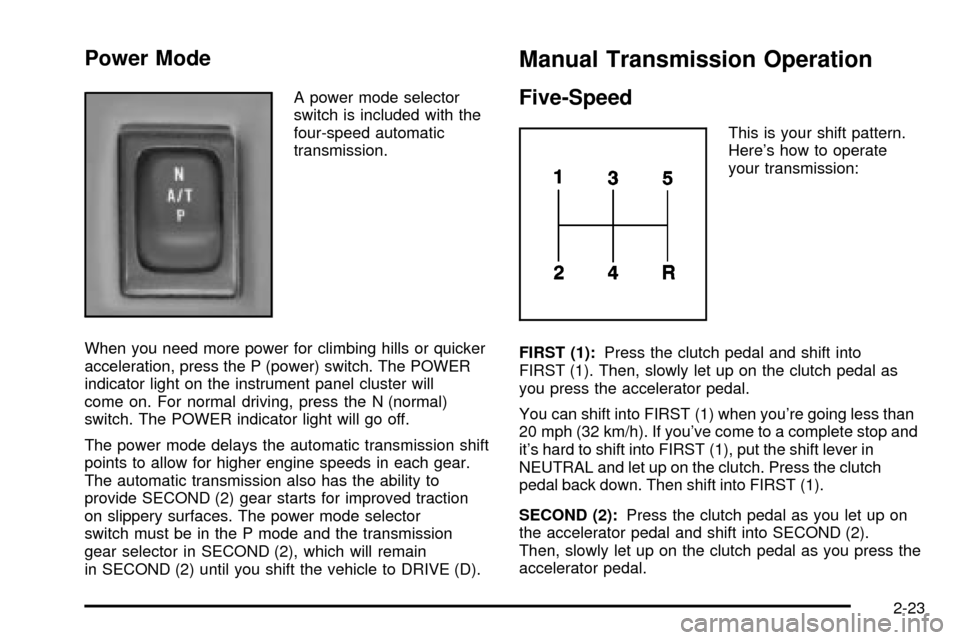
Power Mode
A power mode selector
switch is included with the
four-speed automatic
transmission.
When you need more power for climbing hills or quicker
acceleration, press the P (power) switch. The POWER
indicator light on the instrument panel cluster will
come on. For normal driving, press the N (normal)
switch. The POWER indicator light will go off.
The power mode delays the automatic transmission shift
points to allow for higher engine speeds in each gear.
The automatic transmission also has the ability to
provide SECOND (2) gear starts for improved traction
on slippery surfaces. The power mode selector
switch must be in the P mode and the transmission
gear selector in SECOND (2), which will remain
in SECOND (2) until you shift the vehicle to DRIVE (D).
Manual Transmission Operation
Five-Speed
This is your shift pattern.
Here's how to operate
your transmission:
FIRST (1):Press the clutch pedal and shift into
FIRST (1). Then, slowly let up on the clutch pedal as
you press the accelerator pedal.
You can shift into FIRST (1) when you're going less than
20 mph (32 km/h). If you've come to a complete stop and
it's hard to shift into FIRST (1), put the shift lever in
NEUTRAL and let up on the clutch. Press the clutch
pedal back down. Then shift into FIRST (1).
SECOND (2):Press the clutch pedal as you let up on
the accelerator pedal and shift into SECOND (2).
Then, slowly let up on the clutch pedal as you press the
accelerator pedal.
2-23
Page 92 of 372
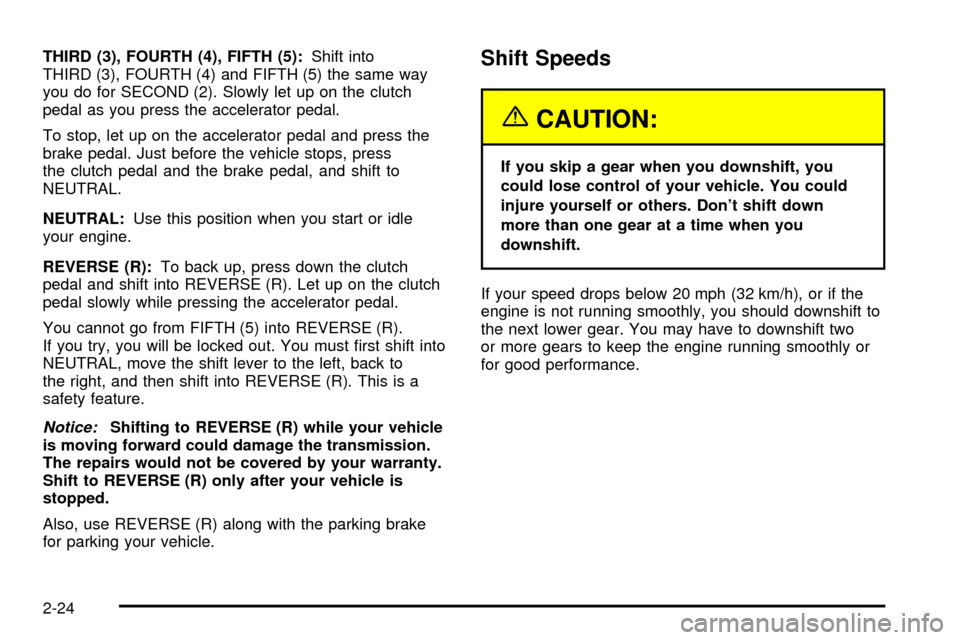
THIRD (3), FOURTH (4), FIFTH (5):Shift into
THIRD (3), FOURTH (4) and FIFTH (5) the same way
you do for SECOND (2). Slowly let up on the clutch
pedal as you press the accelerator pedal.
To stop, let up on the accelerator pedal and press the
brake pedal. Just before the vehicle stops, press
the clutch pedal and the brake pedal, and shift to
NEUTRAL.
NEUTRAL:Use this position when you start or idle
your engine.
REVERSE (R):To back up, press down the clutch
pedal and shift into REVERSE (R). Let up on the clutch
pedal slowly while pressing the accelerator pedal.
You cannot go from FIFTH (5) into REVERSE (R).
If you try, you will be locked out. You must ®rst shift into
NEUTRAL, move the shift lever to the left, back to
the right, and then shift into REVERSE (R). This is a
safety feature.
Notice:Shifting to REVERSE (R) while your vehicle
is moving forward could damage the transmission.
The repairs would not be covered by your warranty.
Shift to REVERSE (R) only after your vehicle is
stopped.
Also, use REVERSE (R) along with the parking brake
for parking your vehicle.
Shift Speeds
{CAUTION:
If you skip a gear when you downshift, you
could lose control of your vehicle. You could
injure yourself or others. Don't shift down
more than one gear at a time when you
downshift.
If your speed drops below 20 mph (32 km/h), or if the
engine is not running smoothly, you should downshift to
the next lower gear. You may have to downshift two
or more gears to keep the engine running smoothly or
for good performance.
2-24
Page 93 of 372
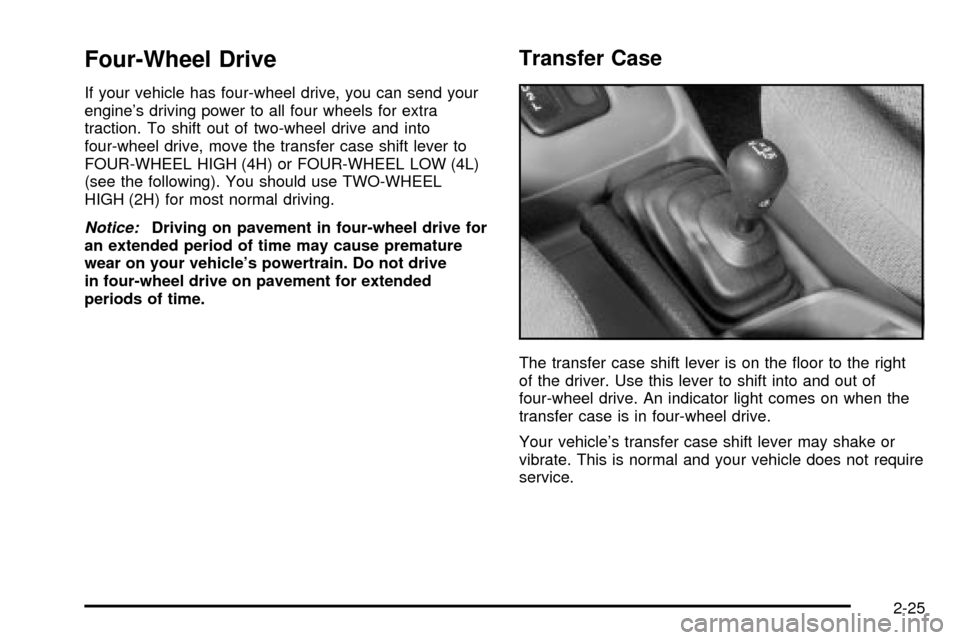
Four-Wheel Drive
If your vehicle has four-wheel drive, you can send your
engine's driving power to all four wheels for extra
traction. To shift out of two-wheel drive and into
four-wheel drive, move the transfer case shift lever to
FOUR-WHEEL HIGH (4H) or FOUR-WHEEL LOW (4L)
(see the following). You should use TWO-WHEEL
HIGH (2H) for most normal driving.
Notice:Driving on pavement in four-wheel drive for
an extended period of time may cause premature
wear on your vehicle's powertrain. Do not drive
in four-wheel drive on pavement for extended
periods of time.
Transfer Case
The transfer case shift lever is on the ¯oor to the right
of the driver. Use this lever to shift into and out of
four-wheel drive. An indicator light comes on when the
transfer case is in four-wheel drive.
Your vehicle's transfer case shift lever may shake or
vibrate. This is normal and your vehicle does not require
service.
2-25
Page 96 of 372
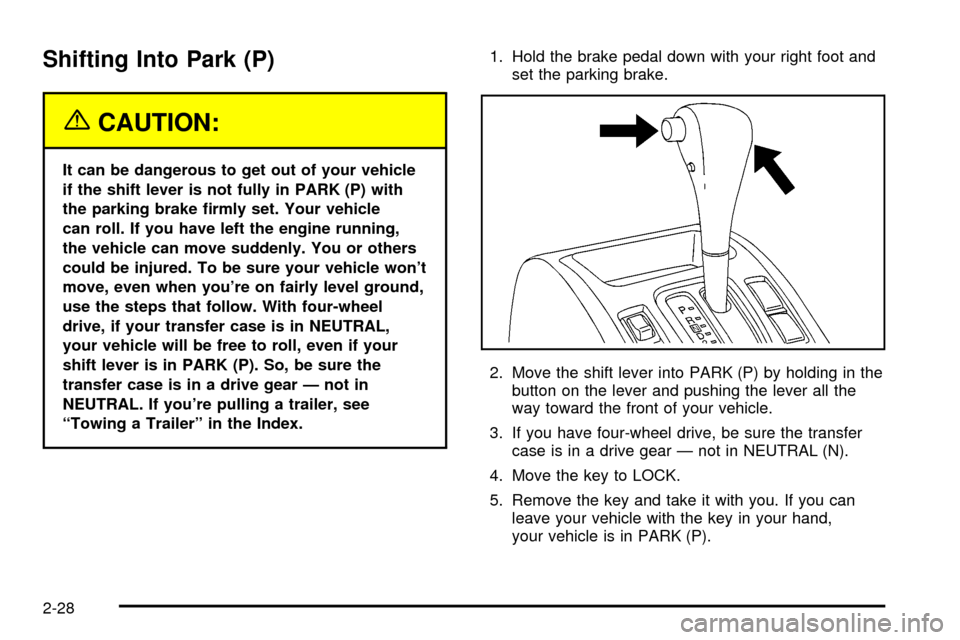
Shifting Into Park (P)
{CAUTION:
It can be dangerous to get out of your vehicle
if the shift lever is not fully in PARK (P) with
the parking brake ®rmly set. Your vehicle
can roll. If you have left the engine running,
the vehicle can move suddenly. You or others
could be injured. To be sure your vehicle won't
move, even when you're on fairly level ground,
use the steps that follow. With four-wheel
drive, if your transfer case is in NEUTRAL,
your vehicle will be free to roll, even if your
shift lever is in PARK (P). So, be sure the
transfer case is in a drive gear Ð not in
NEUTRAL. If you're pulling a trailer, see
ªTowing a Trailerº in the Index.1. Hold the brake pedal down with your right foot and
set the parking brake.
2. Move the shift lever into PARK (P) by holding in the
button on the lever and pushing the lever all the
way toward the front of your vehicle.
3. If you have four-wheel drive, be sure the transfer
case is in a drive gear Ð not in NEUTRAL (N).
4. Move the key to LOCK.
5. Remove the key and take it with you. If you can
leave your vehicle with the key in your hand,
your vehicle is in PARK (P).
2-28
Page 97 of 372
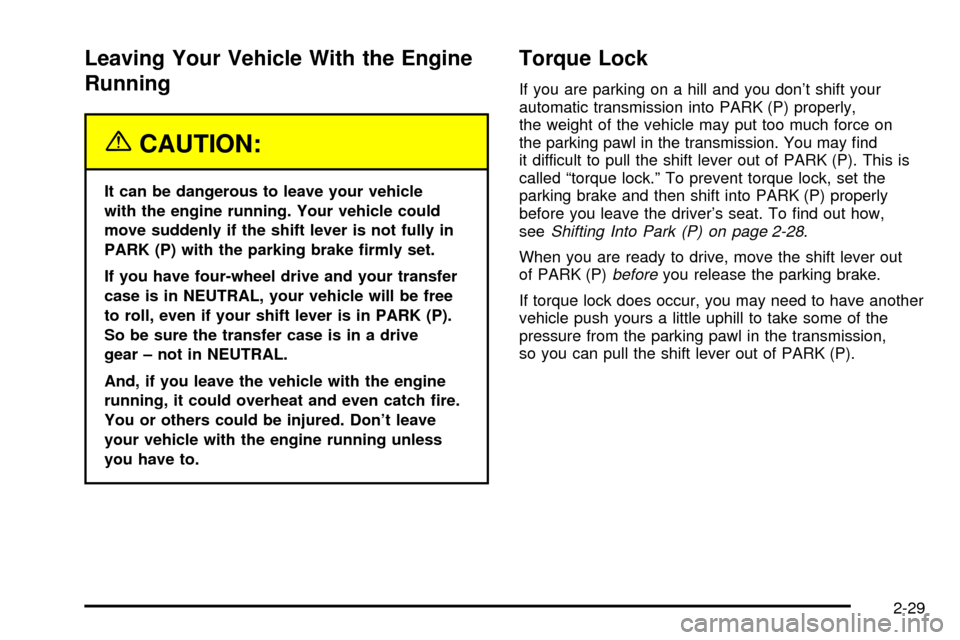
Leaving Your Vehicle With the Engine
Running
{CAUTION:
It can be dangerous to leave your vehicle
with the engine running. Your vehicle could
move suddenly if the shift lever is not fully in
PARK (P) with the parking brake ®rmly set.
If you have four-wheel drive and your transfer
case is in NEUTRAL, your vehicle will be free
to roll, even if your shift lever is in PARK (P).
So be sure the transfer case is in a drive
gear ± not in NEUTRAL.
And, if you leave the vehicle with the engine
running, it could overheat and even catch ®re.
You or others could be injured. Don't leave
your vehicle with the engine running unless
you have to.
Torque Lock
If you are parking on a hill and you don't shift your
automatic transmission into PARK (P) properly,
the weight of the vehicle may put too much force on
the parking pawl in the transmission. You may ®nd
it difficult to pull the shift lever out of PARK (P). This is
called ªtorque lock.º To prevent torque lock, set the
parking brake and then shift into PARK (P) properly
before you leave the driver's seat. To ®nd out how,
see
Shifting Into Park (P) on page 2-28.
When you are ready to drive, move the shift lever out
of PARK (P)
beforeyou release the parking brake.
If torque lock does occur, you may need to have another
vehicle push yours a little uphill to take some of the
pressure from the parking pawl in the transmission,
so you can pull the shift lever out of PARK (P).
2-29
Page 98 of 372

Shifting Out of Park (P)
Your vehicle has an automatic transmission shift lock
control system. You have to fully apply your regular
brakes before you can shift from PARK (P) when
the ignition is in the ON position. See
Automatic
Transmission Operation on page 2-19.
If you cannot shift out of PARK (P), ease pressure on
the shift lever ± push the shift lever all the way into
PARK (P) and release the shift lever button as
you maintain brake application. Then press the shift
lever button and move the shift lever into the gear you
wish to be in.If you ever hold the brake pedal down but still can't shift
out of PARK (P), try this:
1. Apply the parking brake until the end of Step 6.
2. If the engine is running, turn it off. Turn the key to
ON or ACC.
3. Find the access hole cover on the driver's side of
the console, near the shift lever.
4. Remove the screw and cover.
2-30
Page 100 of 372

Engine Exhaust
{CAUTION:
Engine exhaust can kill. It contains the gas
carbon monoxide (CO), which you can not see
or smell. It can cause unconsciousness and
death.
You might have exhaust coming in if:
·Your exhaust system sounds strange or
different.
·Your vehicle gets rusty underneath.
·Your vehicle was damaged in a collision.
·Your vehicle was damaged when driving
over high points on the road or over road
debris.
·Repairs were not done correctly.
·Your vehicle or exhaust system had been
modi®ed improperly.
If you ever suspect exhaust is coming into your
vehicle:
·Drive it only with all the windows down to
blow out any CO; and
·Have your vehicle ®xed immediately.
Running Your Engine While You
Are Parked
It is better not to park with the engine running. But if
you ever have to, here are some things to know.
{CAUTION:
Idling the engine with the climate control
system off could allow dangerous exhaust into
your vehicle. See the earlier Caution under
Engine Exhaust on page 2-32.
Also, idling in a closed-in place can let deadly
carbon monoxide (CO) into your vehicle even if
the climate control fan is at the highest setting.
One place this can happen is a garage.
Exhaust Ð with CO Ð can come in easily.
NEVER park in a garage with the engine
running.
Another closed-in place can be a blizzard.
See
Winter Driving on page 4-40.
2-32
Page 101 of 372
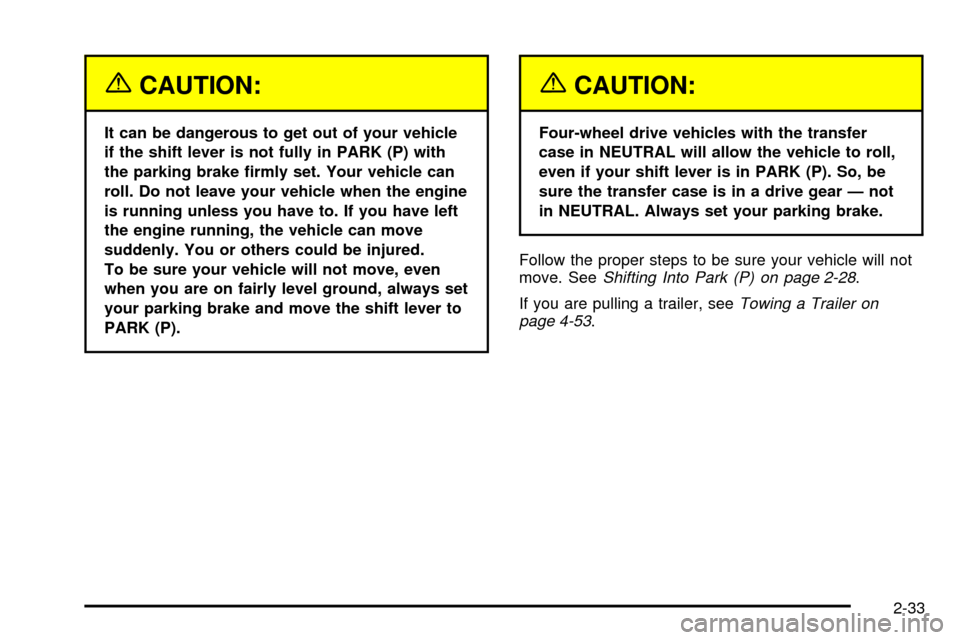
{CAUTION:
It can be dangerous to get out of your vehicle
if the shift lever is not fully in PARK (P) with
the parking brake ®rmly set. Your vehicle can
roll. Do not leave your vehicle when the engine
is running unless you have to. If you have left
the engine running, the vehicle can move
suddenly. You or others could be injured.
To be sure your vehicle will not move, even
when you are on fairly level ground, always set
your parking brake and move the shift lever to
PARK (P).
{CAUTION:
Four-wheel drive vehicles with the transfer
case in NEUTRAL will allow the vehicle to roll,
even if your shift lever is in PARK (P). So, be
sure the transfer case is in a drive gear Ð not
in NEUTRAL. Always set your parking brake.
Follow the proper steps to be sure your vehicle will not
move. See
Shifting Into Park (P) on page 2-28.
If you are pulling a trailer, see
Towing a Trailer on
page 4-53.
2-33
Page 113 of 372

Instrument Panel Overview...............................3-2
Hazard Warning Flashers................................3-4
Other Warning Devices...................................3-4
Horn.............................................................3-4
Tilt Wheel.....................................................3-5
Turn Signal/Multifunction Lever.........................3-5
Exterior Lamps.............................................3-12
Interior Lamps..............................................3-15
Accessory Power Outlets...............................3-17
Ashtrays and Cigarette Lighter........................3-17
Climate Controls............................................3-18
Climate Control System.................................3-18
Outlet Adjustment.........................................3-21
Passenger Compartment Air Filter...................3-22
Warning Lights, Gages and Indicators.............3-24
Instrument Panel Cluster................................3-25
Speedometer and Odometer...........................3-26
Tachometer.................................................3-26
Safety Belt Reminder Light.............................3-26Air Bag Readiness Light................................3-27
Charging System Light..................................3-28
Brake System Warning Light..........................3-28
Anti-Lock Brake System Warning Light.............3-30
Engine Coolant Temperature Gage..................3-31
Malfunction Indicator Lamp.............................3-31
Oil Pressure Light.........................................3-34
Overdrive Off Light........................................3-35
Four-Wheel-Drive Light..................................3-35
Power Indicator Light.....................................3-36
Fuel Gage...................................................3-36
Audio System(s).............................................3-37
Setting the Time...........................................3-37
Radio with CD..............................................3-38
Understanding Radio Reception......................3-42
Care of Your CDs.........................................3-43
Care of Your CD Player................................3-43
Fixed Mast Antenna......................................3-43
Section 3 Instrument Panel
3-1
Page 125 of 372

Daytime Running Lamps
Daytime Running Lamps (DRL) can make it easier for
others to see the front of your vehicle during the
day. DRL can be helpful in many different driving
conditions, but they can be especially helpful in the short
periods after dawn and before sunset. Fully functional
daytime running lamps are required on all vehicles
®rst sold in Canada.
The DRL system will make your headlamps come on at
a reduced brightness when the three following
conditions are met:
·The ignition is on with the engine running,
·the exterior lamps control is off or the parking lights
are on, and
·the parking brake is released.
When the DRL are on, only your headlamps will be on
at a reduced brightness. The taillamps, sidemarker
and other lamps won't be on. Your instrument panel
won't be lit up either.When you move the exterior lamps control to the
headlamp position, your DRL will go off and your
headlamps will come on. The other lamps that come on
with your headlamps will also come on.
When it begins to get dark, the headlamps will
automatically switch from DRL to the regular headlamps.
See ªAutomatic Headlamp Systemº following.
When you turn the exterior lamp control to off, the
regular lamps will go off and your headlamps will change
to the reduced brightness of DRL provided it is not
dark outside. DRL will also come on if only the parking
lamps are being used.
As with any vehicle, you should turn on the regular
headlamp system when you need it.
3-13